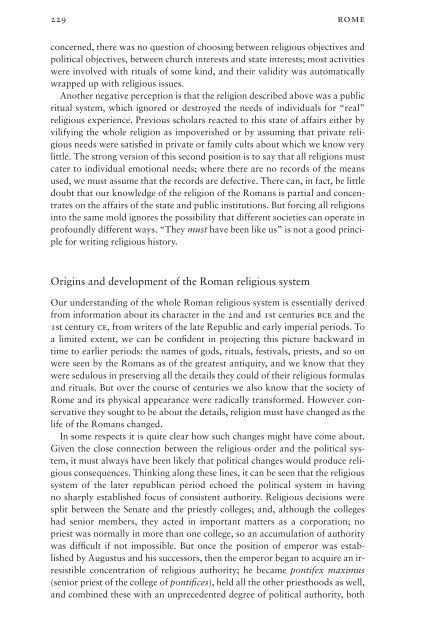Create successful ePaper yourself
Turn your PDF publications into a flip-book with our unique Google optimized e-Paper software.
229 rome<br />
concerned, there was no question of choosing between religious objectives and<br />
political objectives, between church interests and state interests; most activities<br />
were involved with rituals of some kind, and their validity was automatically<br />
wrapped up with religious issues.<br />
Another negative perception is that the religion described above was a public<br />
ritual system, which ignored or destroyed the needs of individuals for “real”<br />
religious experience. Previous scholars reacted to this state of affairs either by<br />
vilifying the whole religion as impoverished or by assuming that private religious<br />
needs were satisfied in private or family cults about which we know very<br />
little. The strong version of this second position is to say that all <strong>religions</strong> must<br />
cater to individual emotional needs; where there are no records of the means<br />
used, we must assume that the records are defective. There can, in fact, be little<br />
doubt that our knowledge of the religion of the Romans is partial and concentrates<br />
on the affairs of the state and public institutions. But forcing all <strong>religions</strong><br />
into the same mold ignores the possibility that different societies can operate in<br />
profoundly different ways. “They must have been like us” is not a good principle<br />
for writing religious history.<br />
Origins and development of the Roman religious system<br />
Our understanding of the whole Roman religious system is essentially derived<br />
from information about its character in the 2nd and 1st centuries bce and the<br />
1st century ce, from writers of the late Republic and early imperial periods. To<br />
a limited extent, we can be confident in projecting this picture backward in<br />
time to earlier periods: the names of gods, rituals, festivals, priests, and so on<br />
were seen by the Romans as of the greatest antiquity, and we know that they<br />
were sedulous in preserving all the details they could of their religious formulas<br />
and rituals. But over the course of centuries we also know that the society of<br />
Rome and its physical appearance were radically transformed. However conservative<br />
they sought to be about the details, religion must have changed as the<br />
life of the Romans changed.<br />
In some respects it is quite clear how such changes might have come about.<br />
Given the close connection between the religious order and the political system,<br />
it must always have been likely that political changes would produce religious<br />
consequences. Thinking along these lines, it can be seen that the religious<br />
system of the later republican period echoed the political system in having<br />
no sharply established focus of consistent authority. Religious decisions were<br />
split between the Senate and the priestly colleges; and, although the colleges<br />
had senior members, they acted in important matters as a corporation; no<br />
priest was normally in more than one college, so an accumulation of authority<br />
was difficult if not impossible. But once the position of emperor was established<br />
by Augustus and his successors, then the emperor began to acquire an irresistible<br />
concentration of religious authority; he became pontifex maximus<br />
(senior priest of the college of pontifices), held all the other priesthoods as well,<br />
and combined these with an unprecedented degree of political authority, both








